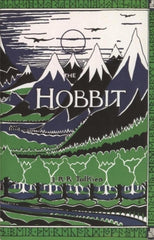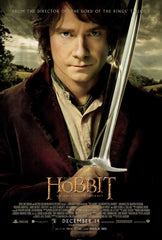There and Back Again: Tolkien and Jackson's Hobbits
by Bethany Wagner
 Just moments into the first installment of The Hobbit film, Bilbo Baggins recites the timeless words that kick off Tolkien’s beloved novel: “In a hole in the ground, there lived a hobbit. Not a nasty, dirty, wet hole…it was a hobbit-hole, and that means comfort.”
Just moments into the first installment of The Hobbit film, Bilbo Baggins recites the timeless words that kick off Tolkien’s beloved novel: “In a hole in the ground, there lived a hobbit. Not a nasty, dirty, wet hole…it was a hobbit-hole, and that means comfort.”In the book, this opening sets the stage for a comfort-loving hobbit to step outside the bounds of his home, face dangers, and become a part of a sweeping narrative involving dwarves and elves, trolls and goblins, a menacing dragon and a final battle.
But even though these factors are the stuff of legend, this story is not centrally the grandiose story of battles or death or action-packed deeds of heroism. It is the simple, almost quiet story of a hobbit barely brave enough to leave his home who scrapes up the courage to perform small acts that make incredible differences—facing hungry trolls, picking up a ring, winning a game of riddles, sneaking into a dragon’s lair.
Jackson’s films do contain moments that faithfully capture the simple struggles of the novel. “I’m looking for someone to share with in an adventure,” says Gandalf to Bilbo, as the hobbit is sitting outside his abode on a quiet sunny morning smoking his pipe. “No adventures around here…nasty things, make you late for dinner,” replies Bilbo firmly. And after he decides to follow, Bilbo insists on turning back because he has forgotten his handkerchief. In another touching scene, Bilbo decides to leave the dwarves because he feels worthless. “You belong with us,” says Bofur. Further scenes such as these bring to light the emotion and unexpected courage of Tolkien’s original tale.
But Jackson’s film features thrilling chases, harrowing escapes, and action-packed battle scenes embellished or not included in the book. The orc Azog pursues the dwarves seeking revenge, resulting in new scenes of battling and death, and initiating a plot driving much of the first movie. The wood elves take up a new role in the film as Legolas and Turiel—neither of whom appear in the book—bound between trees and atop barrels, rescuing the dwarves from orcs and even instigating a love triangle.
On the other hand, Tolkien’s Bilbo is not a solider. He is not an action hero. He does not charge forward to attack Wargs and Orcs. Though he has chosen to go on an adventure, he is still a hobbit—an extraordinary hobbit, but also a quiet, home-loving hobbit who musters up enough courage against all odds. And the courage he finds allows him not to attack opposing armies but to leave his home, win a deadly game of riddles, and sneak around unseen. He is clever and stealthy, accomplishing what the seasoned dwarf soldiers and wizard Gandalf cannot: the work of a burglar. In Jackson’s hands, these stories come to life as heroic, action-packed adventures with a thrill of their own, as seen in the upcoming final installment's title: The Hobbit: The Battle of the Five Armies. Superb acting and spectacular special effects certainly makes the franchise a work of cinematic art in its own right. However, the films perhaps lack the warmth and charm that makes Tolkien’s novel a classic, beloved by generations who were encouraged by a small hobbit brave enough to leave his home.
Check back next Thursday as we take a look at Sir Arthur Conan Doyle's Sherlock Holmes masterpieces of mystery and BBC's new modern television adaptation Sherlock.
--
Book Cover artwork by J.R.R. Tolkien
